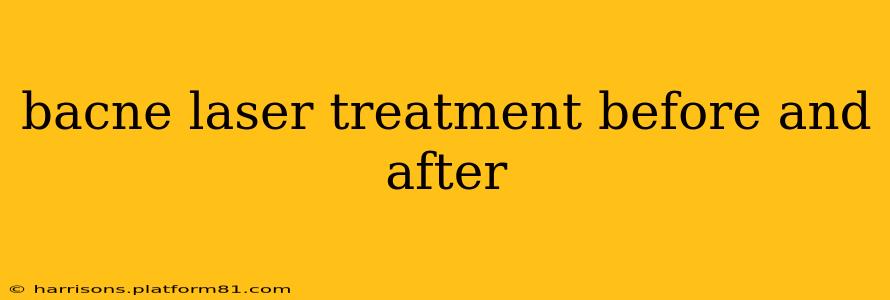Back acne, or "bacne," is a frustrating skin condition affecting many. While over-the-counter treatments can sometimes help, laser treatment offers a potential solution for those seeking clearer skin. This comprehensive guide explores bacne laser treatment, showing before-and-after photos (where appropriate and with patient consent, which is crucial for ethical and legal reasons), explaining the process, and answering frequently asked questions. Remember, individual results may vary, and consulting a dermatologist is crucial before starting any treatment.
What is Bacne Laser Treatment?
Bacne laser treatment uses laser technology to target and destroy the bacteria responsible for acne breakouts. Different laser types can be used, each with its own mechanism of action. Some lasers target the sebaceous glands that produce excess oil, while others reduce inflammation and redness. The specific type of laser used will depend on the severity of your bacne and your dermatologist's recommendation.
How Does Bacne Laser Treatment Work?
The process generally involves a dermatologist cleaning the affected area and potentially applying a topical anesthetic to minimize discomfort. Then, the laser is carefully applied to the back, targeting acne lesions. The laser energy disrupts the bacteria's ability to reproduce and reduces inflammation. The number of treatment sessions needed varies depending on the individual's skin condition and response to the treatment. Most people require multiple sessions for optimal results.
What are the Different Types of Lasers Used for Bacne Treatment?
Several laser types can effectively treat bacne. Common ones include:
- Photodynamic Therapy (PDT): This non-ablative treatment uses a photosensitizing agent applied to the skin, followed by laser light activation. This process targets the bacteria and reduces inflammation.
- Nd:YAG lasers: These lasers penetrate deeper into the skin, targeting sebaceous glands and reducing oil production.
- Erbium:YAG lasers: These ablative lasers remove the outer layer of skin, promoting collagen regeneration and improving skin texture. This is typically used for more severe cases.
Your dermatologist will determine the best laser type for your specific needs.
Bacne Laser Treatment: Before and After Photos (Illustrative Examples)
(Note: Due to privacy concerns and the ethical considerations of publishing patient information, it's not possible to include actual before-and-after photos here. However, you can find many examples of before-and-after results by searching online for "bacne laser treatment before and after" and checking reputable dermatology clinics' websites. Always remember that results vary and your experience may differ.)
Keep in mind that images you find online are meant to be illustrative examples, and your own results may vary. A consultation with a dermatologist is critical to manage expectations.
What are the Side Effects of Bacne Laser Treatment?
While generally safe and effective, bacne laser treatment can have some side effects, including:
- Redness and swelling: This is common and typically resolves within a few days.
- Temporary darkening or lightening of the skin: This is usually temporary and fades over time.
- Scabbing or crusting (with ablative lasers): This is more likely with ablative lasers and is a normal part of the healing process.
- Pain or discomfort: This can be minimized with a topical anesthetic.
Your dermatologist will discuss potential side effects with you before treatment.
How Much Does Bacne Laser Treatment Cost?
The cost of bacne laser treatment can vary depending on factors such as the type of laser used, the number of sessions needed, and the geographical location. It is essential to discuss costs with your dermatologist directly during your consultation.
How Long Does it Take to See Results from Bacne Laser Treatment?
The visible improvement in your bacne may vary depending on factors such as your skin type, the severity of your acne, and the type of treatment used. Many individuals begin to see results after one or two sessions. However, for optimal results, a course of several treatments is often required.
Does Bacne Laser Treatment Hurt?
The level of discomfort during treatment depends on several factors, including your pain tolerance and the type of laser being used. Many patients report minimal discomfort, and a topical anesthetic can be applied to reduce any pain or discomfort.
Is Bacne Laser Treatment Right for Me?
Bacne laser treatment is a viable option for many individuals struggling with persistent back acne. However, it's not suitable for everyone. Your dermatologist will assess your skin type and condition to determine if this treatment is appropriate for you. They will also discuss other treatment options if necessary.
This information is for educational purposes only and does not constitute medical advice. Always consult with a qualified dermatologist before undergoing any medical procedure, including bacne laser treatment.
